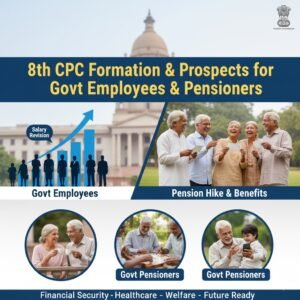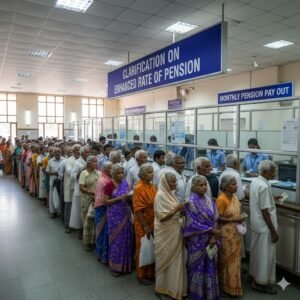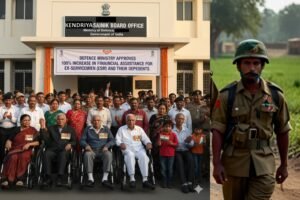The pay structure for Central Government employees in India has undergone significant transformation over the years, driven by recommendations of successive Central Pay Commissions (CPCs). The objective of these revisions has been to ensure fair compensation, transparency, and parity across different roles in the government sector. It is obvious that 8th CPC will study a through on the evolution of such pay scale and according the revision by 8th CPC will be done. This article provides a detailed comparative overview of pay scales across the 4th (1986), 5th (1996), 6th (2006), and 7th (2016) CPCs, including corresponding Pay Bands, Grade Pay, and Pay Matrix Levels.
Evolution of Pay Scales of Central Civil Services Employees of all Cadre including Armed Forces
1. 4th CPC (Effective from 01.01.1986)
The 4th Central Pay Commission introduced structured pay scales based on incremental patterns. A Multiplication factor of 1.86 applied on the existing basic pay of the post as on 01.01.1986 . For example:
- Entry-level Pay Scale: ₹750-12-870-14-940
- Middle-level Scales: ₹1640-60-2600-75-2900, ₹2375-75-3200-100-3500
- Senior Administrative Roles: ₹8000/- (Fixed), ₹9000/- (Fixed)
These pay scales included basic pay along with specified increments over years of service.
5th CPC (Effective from 01.01.1996)
The 5th CPC restructured the earlier system into grades (e.g., S-1 to S-34) with consolidated pay scales. A few examples:
- S-1: ₹2550-55-2660-60-3200 (for lowest levels)
- S-14: ₹7500-250-12000
- S-34: ₹30000 (Fixed) – For Cabinet Secretary
This CPC emphasized rationalization and compression of scales, especially for mid-level posts. 40% of existing Basic pay was added to the total emoluments (standard elements only).
3. 6th CPC (Effective from 01.01.2006)
A major shift occurred with the introduction of Pay Bands and Grade Pay:
- PB-1: ₹5200-20200 with Grade Pay ₹1800 to ₹2800
- PB-2: ₹9300-34800 with Grade Pay ₹4200 to ₹5400
- PB-3: ₹15600-39100 with Grade Pay ₹5400 to ₹7600
- PB-4: ₹37400-67000 with Grade Pay ₹8700 to ₹10000
- HAG and Apex Scales: ₹67000 to ₹80000 (fixed)
This CPC moved toward broad Pay Bands to address stagnation and anomalies in promotions with a with a multiplication factor of 1.86.
7th CPC (Effective from 01.01.2016)
The 7th CPC abolished Grade Pay and introduced a Pay Matrix system with a multiplication factor of 2.57, assigning Levels from 1 to 18. Some corresponding examples:
- Level 1 (₹18,000 – ₹56,900): Entry-level positions previously under S-1, S-2 etc.
- Level 6 (₹35,400 – ₹1,12,400): Mid-level posts from earlier PB-2 with GP ₹4200
- Level 13 (₹1,23,100 – ₹2,15,900): Higher administration (equivalent to Grade Pay ₹8700)
- Level 17 & 18: Apex level and Cabinet Secretary with fixed pay ₹2,25,000 and ₹2,50,000 respectively
This matrix brought about complete transparency, ensured predictability in career progression, and easier calculation of pension benefits.
8th CPC (effective from 01.01.2026) – Expected
Based on the all earlier revision by 4th, 5th, 6th and the 7th CPC it can be assumed that the 8th CPC may revise the abolished Grade Pay and introduced a New Pay Stages system, assigning Stages from 1 to 18 or more/less with some addition / alteration of Pay Scale. Some corresponding examples:
- Level 1 (₹39,600 – ₹56,900): Entry-level positions previously under Level-1 etc.
- Level 6 (₹77,880 – ₹2,47,280): Mid-level posts from earlier Level 6
- Level 13 (₹2,71,000 – ₹2,75,400): Higher administration
- Level 17 & 18: Apex level and Cabinet Secretary with fixed pay ₹4,95,000 and ₹5,50,000 respectively.
Summary Table: Example Mapping Across CPCs
| CPC | Designation Level Example | Pay Scale / Band / Level |
| 4th CPC | LDC/Peon | ₹750-12-870-14-940 |
| 5th CPC | S-1 | ₹2550-55-2660-60-3200 |
| 6th CPC | PB-1 + GP ₹1300 | ₹4440-7440 + GP ₹1300 |
| 7th CPC | Level 1 | ₹18,000 – ₹56,900 |
| 8th CPC | Stage-1 | ₹39,600 – ₹1,25,200 (Expected) |
| — | — | — |
| 4th CPC | Section Officer | ₹2000-60-2300-75-3200 |
| 5th CPC | S-12 | ₹6500-10500 |
| 6th CPC | PB-2 + GP ₹4200 | |
| 7th CPC | Level 6 | ₹35,400 – ₹1,12,400 |
| 8th CPC | Stage 6 | ₹77,880 – ₹2,47,280 (Expected) |
Significance of the Comparative Table
The comparative pay scale table provided by the Department of Pension & Pensioners’ Welfare serves as an essential reference for:
- Pension calculations
- Fixation of pay on promotion or re-employment
- Understanding service parity
- Legal and audit purposes
- Expected Pay scale in 8th CPC
It highlights the evolution of compensation structure and allows employees and administrators to accurately track historical changes for service benefits, retirement dues, or pay protection.
Let’s Hope for the Best from the present Govt
The progression from the 4th to the 7th CPC reflects not just numerical changes but also a philosophical shift in the way public servants are compensated. We may expect the similar pattern of revision of pay in 8th CPC also. The new system emphasizes clarity, simplicity, and equity, promoting a transparent and performance-oriented public administration.
- Complete Guide to AFD-I Entitlements Under CSD for Serving, Retired Defence Personnel & Defence Civilians (2025 Update)The Canteen Stores Department (CSD) provides a wide range of… Read more: Complete Guide to AFD-I Entitlements Under CSD for Serving, Retired Defence Personnel & Defence Civilians (2025 Update)
- Get Direct Support from ESM Info Club: A Dedicated Platform for the Welfare of Veterans and Their FamiliesThe ESM Info Club is a committed welfare initiative dedicated… Read more: Get Direct Support from ESM Info Club: A Dedicated Platform for the Welfare of Veterans and Their Families
- Convert Your Defence Salary Package Account to DSP Pension Account Today Just From Your HomeBenefits applicable to DSP Pension Account Holder Benefits under Pension… Read more: Convert Your Defence Salary Package Account to DSP Pension Account Today Just From Your Home
- Reemployed Exservicemen Must Submit this Certificate to PCDA (P) to Continue DR on PensionIt has been observed that deerness relief of some pensioners… Read more: Reemployed Exservicemen Must Submit this Certificate to PCDA (P) to Continue DR on Pension
- SPARSH will Deduct DR with Life Certificate ? Analysis of PCDA Circular No. 200 and Pension RegulationsRe-employment after military retirement is common among Junior Commissioned Officers… Read more: SPARSH will Deduct DR with Life Certificate ? Analysis of PCDA Circular No. 200 and Pension Regulations
- Intelligence Bureau (IB) MTS Recruitment 2025 – Complete DetailsThe Intelligence Bureau (IB), operating under the Ministry of Home… Read more: Intelligence Bureau (IB) MTS Recruitment 2025 – Complete Details
- Recruitment of Women Sports Athletes in Territorial Army (Home & Hearth) BattalionThe Territorial Army (TA) is initiating a special recruitment drive… Read more: Recruitment of Women Sports Athletes in Territorial Army (Home & Hearth) Battalion
- A Clear Concept of Roles and Responsibilities of Zila Sainik BoardA Detailed information for awareness of Ex-Servicemen Zila Sainik Boards… Read more: A Clear Concept of Roles and Responsibilities of Zila Sainik Board
- Exservicemen may apply for PMSS for Academic Year 2025–26A Comprehensive Guide for Eligible Students and Ex-Servicemen Families The… Read more: Exservicemen may apply for PMSS for Academic Year 2025–26
- India’s Defence Manufacturing on Display at the 44th IITFThe 44th India International Trade Fair (IITF) opens tomorrow, 14… Read more: India’s Defence Manufacturing on Display at the 44th IITF
- Indian Air Force Recruitment 2026 in Officers Cadre – AFCAT 01/2026 & NCC Special Entry (Courses Commencing January 2027)Indian Air Force (IAF) has announced recruitment for men and… Read more: Indian Air Force Recruitment 2026 in Officers Cadre – AFCAT 01/2026 & NCC Special Entry (Courses Commencing January 2027)
- Why 8th CPC Prospects for Highly Improving Pay & Pension of Central Government EmployeesThe Government of India has constituted the 8th Central Pay… Read more: Why 8th CPC Prospects for Highly Improving Pay & Pension of Central Government Employees
- Clarification on Enhanced Rate of Family Pension After Death Post-Retirement — Must Know for all pensionersThe Government of India’s Department of Pension & Pensioners’ Welfare… Read more: Clarification on Enhanced Rate of Family Pension After Death Post-Retirement — Must Know for all pensioners
- Job Fair 2025 for Ex-Servicemen : Organised by DGREmpowering Veterans with New Career Opportunities The Directorate General Resettlement… Read more: Job Fair 2025 for Ex-Servicemen : Organised by DGR
- Defense Ministry Approves 100% Increase in Financial Assistance for Ex-Servicemen (ESM) and Their DependentsGovt Welfare Schemes for Exservicemen On 15 October 2025, the… Read more: Defense Ministry Approves 100% Increase in Financial Assistance for Ex-Servicemen (ESM) and Their Dependents




















